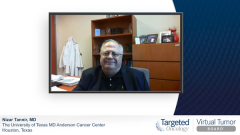
Treatment Regimens for Patients with Advanced Clear Cell RCC and Bone or Liver Metastasis
Key opinion leaders discuss the options for patients with advanced clear cell RCC who have higher-risk metastatic disease.
Episodes in this series

Nizar Tannir, MD: When we look at patients with organ metastasis, maybe the patients will be different if they have lymph node and lung metastasis vs those who have bone or liver metastasis. Scott, back to you on this issue. If a patient presents with bone or liver metastasis—not the patient we just presented who had only lung metastasis—would you think of a different regimen for that? Can you share with us some of the data from the CLEAR (NCT02811861) study about patients who have bone and liver metastasis? Those were prespecified subgroups in the CLEAR study, and there are some data that maybe you’d like to share with us about that.
The other question is that up to 10% of patients with metastatic clear cell RCC [renal cell carcinoma] have sarcomatoid features in their tumors, whether you call it sarcomatoid differentiation or, as we like to call it here at [The University of Texas] MD Anderson [Cancer Center], dedifferentiation. Do you approach those patients with sarcomatoid features in their tumors differently? Maybe you can share with us and our listeners some of your pearls on this.
Scott Tykodi, MD, PhD: Those all definitely cross one’s mind in terms of features of the disease burden and how that might influence your choice of therapy. Shown here on this slide are CLEAR data showing us the IO [immunotherapy] combination, lenvatinib plus pembrolizumab, vs sunitinib, and whether there are sarcomatoid features. We’re seeing aggregate response profile. With sarcomatoid, if we focus on the regimen, there was a 60.7% response rate vs 72% if you don’t, but a very well-preserved response profile in what has historically been a difficult population. Shown here is an odds ratio showing a comparison with sunitinib. Bone metastases had 64% response rates vs 73%, so a very well-preserved response phenotype for the regimen. Liver metastases had 66.7% vs 71.9% response rates.
The take-home message is that you don’t lose a lot of efficacy with the lenvatinib-pembrolizumab regimen in subsets of disease that are considered poor risk and as having poor outcome. Does that lead you toward this regimen specifically? It’s still a good regimen. It was good when you looked at intent-to-treat with everybody. It still looks good when you break it down and you look at some of the subsets that you worry about. The response profile remains robust.
In terms of bone, there’s some literature. Cabozantinib has tried to position itself as a TKI [tyrosine kinase inhibitor] that has preferentially good activity in bone. The salvage METEOR trial (NCT01865747) did a subset analysis of patients with bony metastases, and showed a very favorable hazard ratio vs the everolimus competitor. That has been looked at in the CheckMate 9ER [trial] (NCT03141177) as well, and the hazard ratio was extremely strong. It was in the 0.3 range in the bone metastasis subset. The other regimens also are still favorable in the bone metastasis cohort as well.
Is there proportionally better activity for cabozantinib? It crosses my mind. When I have patients who have a heavy burden of bony disease, I sometimes steer toward cabozantinib. With sarcomatoid disease, If you take a step back to the TKI monotherapy generation, that was a horrible subset in terms of patient outcomes, with highly refractory tumors. When you step forward into the IO world, the IO drugs work wonderfully well for sarcomatoid disease. Everyone says we need to use an IO drug. Do you use the IO doublet ipilimumab-nivolumab, or do you use an IO plus a TKI? What does the TKI bring to the table in the combination regimens? Is it doing anything? Or are you just seeing the fact that IO is very robust for a sarcomatoid differentiated tumor? That’s a little hard to fathom.
I’ve seen data with all of the frontline regimens for sarcomatoid tumors, and they all look pretty good. I don’t feel that there’s a clear pathway or a best in class, but the message is, you’ve got to have an IO on board for your sarcomatoid patients. If you use a TKI in isolation, it isn’t going to go well. This slide is certainly a selling point for lenvatinib-pembrolizumab, but I’m not sure you couldn’t show the same trends for the competing regimens as well.
Nizar Tannir, MD: Thank you, Scott. I’d like to add about sarcomatoid [features]. We published in CCR [Clinical Cancer Research] last year and presented at ASCO GU [American Society of Clinical Oncology Genitourinary Cancers Symposium] 2022 the updated data from CheckMate 214 (NCT02231749) focusing on patients with sarcomatoid features in their tumors. With 5 years’ minimum follow-up for CheckMate 214, the data are really impressive for sarcomatoid tumors treated with nivolumab-ipilimumab, with a CR [complete response] rate of 23% as of the latest update. That’s impressive for sarcomatoid.
The median OS for those patients was 4 years compared with the median of 14 months for patients with sunitinib, which, as you mentioned, hasn’t changed at all over years. It’s still in the era of targeted therapy before IO therapy. The median OS for patients with sarcomatoid has remained fixed at 14 months. That’s absolutely borne [out] in all the randomized phase 3 trials we talked about. For the patients with sarcomatoid histology, I believe nivolumab-ipilimumab provides a high CR rate, a durable CR rate, and an impressive OS, exceeding 4 years. With longer follow-up of the IO-TKI regimens, we’ll see the CR rates and durability of the CR rates for pembrolizumab-axitinib, nivolumab-cabozantinib, and pembrolizumab-lenvatinib. I agree with you on the bone and liver metastases. Any of these IO-TKI regimens provide efficacy data.
Transcript edited for clarity.











































